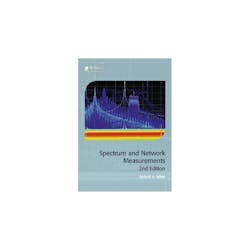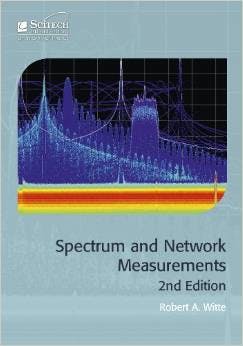Book Review: Spectrum and Network Measurements, 2nd Edition
The 2nd edition of Spectrum and Network Measurements brings Witte’s classic text up to date for readers seeking to know about current measurement technologies, such as modular instruments, fast Fourier Transforms (FFTs), and how other instruments, such as oscilloscopes, fit into a measurement workbench with spectrum and network analyzers.
The clear and concise text includes some early tutorial sections on the meaning of engineering basic parameters, such as the decibel (dB), gain and loss calculations, and how error percentages are denoted in terms of decibels. The book includes chapters on swept spectrum analyzers and their measurements, modulation measurements, distortion measurements, pulsed measurements, network analyzers and their measurements, and electromagnetic-compatibility (EMC) measurements.
The opening chapter serves as an introduction to some of the measurement instruments used for spectrum and network analysis showing for example, images of commercial spectrum and network analyzers and simple block diagrams representing the main functions of these instruments. Graphic images are also presented for typical measurement screens, such as a plot of signal amplitude across a frequency bandwidth for a spectrum analyzer, with details on important display parameters, such as resolution bandwidth, video bandwidth, start and stop frequency, and sweep speed.
Veteran users of spectrum analyzers certain know the interrelationships of these different spectrum-analyzer measurement parameters. But new users will benefit greatly from reading this text and these introductory chapters to better know the capabilities of modern spectrum and network analyzers. This opening chapter closes with several graphical images and details on some of the newer products in this instrument space, including a combination spectrum and network analyzer that operates on battery power in a compact, portable case, and an example of the latest “rage” in RF/microwave measurement equipment, the PXI mainframe filled with PXI instrument modules. The densely packed capabilities of these PXI instruments allow the equivalent of one or more full racks of equipment to fit into a single 19-in. rack-mount chassis.
An interesting early chapter is devoted to Fourier theory, basically to explain the relationships between signals in the frequency and time domains. This chapter includes the mathematical relationships for Fourier series expansions and uses the Fourier series expansion of a square wave as an example of how to apply these mathematical functions. The text includes details on discrete Fourier transforms and fast Fourier transforms (FFTs), providing brief but effective explanations of how and why they are used in modern measurement setups.
Plots are included to show the effects of different levels of harmonic signals when presented with fundamental test tones, with waveforms that contain third, fifth, seventh, and ninth harmonic signals. The text provides the practical relevance of processing harmonic signals and how the amplitude levels of the harmonics relate to the amplitude levels of the fundamental signals being tested. It even details the case of even-order harmonics, which are rarely mentioned in educational materials, but a legitimate concern. As this chapter concludes, it explains that a spectrum analyzer is capable of measuring the levels of even-order harmonic signals although an oscilloscope cannot.
The chapter on Fourier transforms serves as an excellent lead-in to a chapter on FFT analyzers and how they function in the measurement of high-frequency signals. A simple block diagram is included to illustrate a signal flow diagram from input, through variable attenuator, lowpass filter, sampler, analog-to-digital converter (ADC), and then FFT analysis in a microprocessor and presentation of analyzed signals on the FFT analyzer’s display screen. Summation equations are included to describe the role of waveform sampling in capturing and displaying signals in an FFT analyzer, and simple sampling theory is presented to explain the minimum levels of sampling required to accurately represent a captured waveform in digital form.
This chapter includes an explanation of one of the measurement capabilities that has been fairly unique to FFT analyzers, the generation of spectral maps. A graphic is displayed with an oscillator as an example of how spectral maps from an FFT analyzer can be used to analyze harmonic distortion and other oscillator imperfections when evaluating a signal source. The FFT chapter also explains other useful display capabilities, such as histograms and how they are used to show how a signal’s amplitude is distributed between its minimum and maximum values. Essentially, a histogram displays the number of samples versus amplitude for an analyzed signal. It can be used for determining the statistical properties of noise and other signal properties, and used to produce analytical tools, such as probability density functions (PDFs) and cumulative density functions (CDFs) that aid in analyzing noise characteristics.
Veteran users of spectrum analyzers will appreciate a chapter devoted to swept spectrum analyzers and how these measurements have long supported signal analysis in the RF/microwave industry. A swept spectrum analyzer expands the capability of a wave analyzer to measure one frequency at a time and sweeps the analyzer’s local oscillator (LO) across a frequency range of interest to measure the amplitude as a function of frequency for that bandwidth. Several simple block diagrams are included for swept spectrum analyzers, with and without microprocessor control, and important details are included on how different parameters, such as sweep speed and LO feedthrough, can affect measurement accuracy.
Explanations are provided for the role of the digital intermediate-frequency (IF) section in modern swept spectrum analyzers and the functions of different types of detectors (such as normal, average, and peak detectors) and how they are used for different measurements with a swept spectrum analyzer. The chapter explores the impact of a tracking generator on swept spectrum measurements, and also compares the capabilities of swept spectrum measurements and FFT analyzer measurements. It concludes with an introduction to the real-time spectrum analyzer (RTSA) and what various parameters on an RTSA data sheet, such as probability of intercept (POI), mean in a practical sense.
Additional chapters cover modulation measurements, including amplitude modulation (AM) and frequency modulation (FM), quadrature modulation, error vector magnitude (EVM), distortion measurements, including harmonic distortion and intermodulation distortion, noise and noise measurements, including the meaning of equivalent noise bandwidth and how to make critical noise measurements, such as phase-noise measurements, and pulse measurements, including how to analyze and understand different pulse signal parameters.
This is an ambitious text that covers a great deal of ground related to spectrum and network measurements. It even includes chapters on transmission lines and coaxial connectors, why they are important in modern high-frequency systems, but how such factors as impedance mismatches can impact the accuracy of different spectrum and network measurements. Obviously, this one book cannot cover all the history and engineering details related to RF/microwave spectrum and network measurements. But it is an excellent starting place. And it includes many helpful hints, such as the use of different components, such as power dividers/combiners and attenuators for improving return loss and other parameters related to enhancing measurement accuracy.
2014, 350 pp., hardcover, ISBN: 978-1-61353-014-6, SciTech Publishing, Edison, NJ
About the Author
Jack Browne
Technical Contributor
Jack Browne, Technical Contributor, has worked in technical publishing for over 30 years. He managed the content and production of three technical journals while at the American Institute of Physics, including Medical Physics and the Journal of Vacuum Science & Technology. He has been a Publisher and Editor for Penton Media, started the firm’s Wireless Symposium & Exhibition trade show in 1993, and currently serves as Technical Contributor for that company's Microwaves & RF magazine. Browne, who holds a BS in Mathematics from City College of New York and BA degrees in English and Philosophy from Fordham University, is a member of the IEEE.

